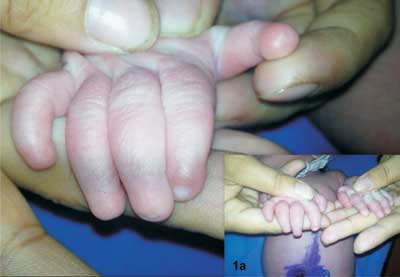A 4-month-old infant presented with absence of eight
fingernails and five toenails since birth (Fig. 1). There
was no abnormality in the bones or teeth. Radiological examination of
the hands and feet showed no abnormality. The infant did not have any
delay in developmental milestones. Family history was non-contributory.
A diagnosis of congenital non-syndromic partial anonychia was made.
 |
|
Fig. 1 Absence of the finger nails
in congenital anonychia.
|
Anonychia refers to absence of nail plate with an
autosomal dominant or recessive inheritance. Congenital anonychia is
rare and may be associated with other ectodermal or mesodermal
malformations like epidermolysis bullosa, DOOR syndrome (deafness,
onychodystrophy, osteodystrophy, and mental retardation) and Iso-Kikuchi
syndrome. It is caused due to mutations in the exon 2 of R-spondin 4
gene located on chromosome 20p13. Artificial nails are a treatment
option.

